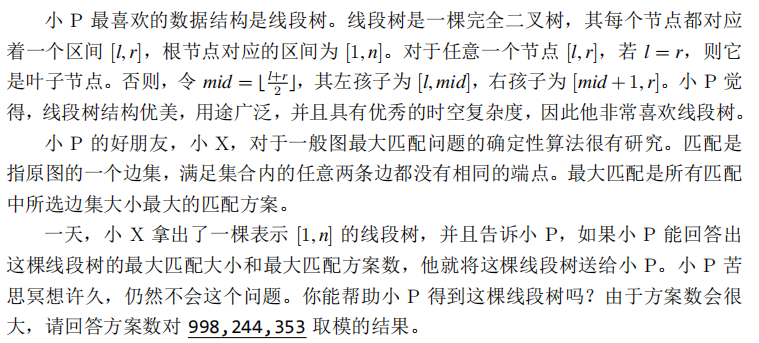description

analysis
-
对于普通树形(DP)可以设(f[i][0/1],g[i][0/1])表示([1,i])的线段树的最大值、方案数
-
(0)表示不选择根与某个儿子相连,(1)表示选择根与某个儿子相连,由({iover 2},i-{iover 2})转移得到
-
转移
很不好想,这是(70pts)的方法,注意有很多节点信息是不需要知道的 -
一棵线段树最多只会有(log)个不相同的节点,剩下的可以只搞一次得到
-
对于(DP)的优化,记忆化搜索加哈希就可以记下已经弄过的节点了
code
#pragma GCC optimize("O3")
#pragma G++ optimize("O3")
#include<stdio.h>
#include<string.h>
#include<algorithm>
#define ha 9260817
#define mod 998244353
#define china 19491001
#define ll long long
#define reg register ll
#define fo(i,a,b) for (reg i=a;i<=b;++i)
#define fd(i,a,b) for (reg i=a;i>=b;--i)
using namespace std;
ll n,T,now;
struct node{ll x,f[2],g[2];}tmp,hash[ha+5];
inline ll read()
{
ll x=0,f=1;char ch=getchar();
while (ch<'0' || '9'<ch){if (ch=='-')f=-1;ch=getchar();}
while ('0'<=ch && ch<='9')x=x*10+ch-'0',ch=getchar();
return x*f;
}
inline bool judge(ll x)
{
for (now=x%ha*china%ha;;now=now==ha?0:now+1)
{
if (!hash[now].x)return 0;
if (hash[now].x==x)return 1;
}
}
inline node dfs(ll x)
{
if (judge(x))return hash[now];
ll l=x/2,r=x-l;
node tmpp,tmpl=dfs(l),tmpr=dfs(r);
tmpp.x=x,tmpp.f[0]=tmpp.f[1]=tmpp.g[0]=tmpp.g[1]=0;
fo(j,0,1)fo(k,0,1)
{
tmpp.f[0]=max(tmpp.f[0],tmpl.f[j]+tmpr.f[k]);
if (j!=1 || k!=1)tmpp.f[1]=max(tmpp.f[1],tmpl.f[j]+tmpr.f[k]+1);
}
fo(j,0,1)fo(k,0,1)
{
if (tmpl.f[j]+tmpr.f[k]==tmpp.f[0])(tmpp.g[0]+=tmpl.g[j]*tmpr.g[k])%=mod;
if (j!=1 || k!=1)
{
ll cnt=(!j && !k?2:1)*tmpl.g[j]*tmpr.g[k]%mod;
if (tmpl.f[j]+tmpr.f[k]+1==tmpp.f[1])(tmpp.g[1]+=cnt)%=mod;
}
}
for (now=x%ha*china%ha;;now=now==ha?0:now+1)if (!hash[now].x){hash[now]=tmpp;return tmpp;}
}
int main()
{
freopen("match.in","r",stdin);
freopen("match.out","w",stdout);
T=read();
hash[china%ha].x=1,hash[china%ha].g[0]=1,hash[china%ha].g[1]=0;
hash[2*china%ha].x=2,hash[2*china%ha].f[1]=1,hash[2*china%ha].g[0]=1,hash[2*china%ha].g[1]=2;
while (T--)n=read(),tmp=dfs(n),printf("%lld %lld
",tmp.f[1],tmp.f[0]==tmp.f[1]?(tmp.g[0]+tmp.g[1])%mod:tmp.g[1]);
return 0;
}